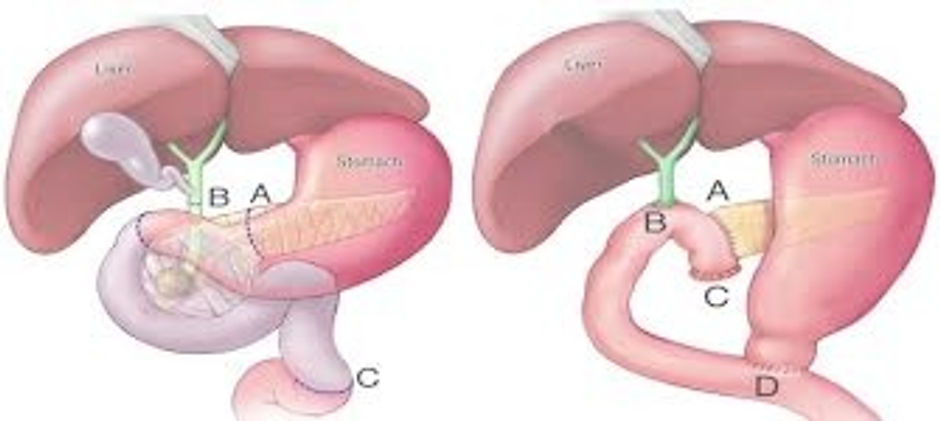Pancreas
Whipple’s Pancreatoduodenectomy:
This is a complex surgery (procedure) which involves removal of distal part of the stomach (in conventional whipple’s procedure), the duodenum, the gall bladder, the common bile duct, the head, uncinate process and neck of the pancreas. In what we call as pylorus preserving whipple’s procedure, we preserve the stomach. This procedure is performed for the tumors of the distal bile duct, tumors of the duodenum, tumors arising in the head and uncinate process of the pancreas and the periampullary region.
The below pictures represent schematically Whipple’s procedure5-6% of patients undergo this procedure for benign conditions such as duodenal diverticulum, recurrent inflammation in the head of pancreas not able to differentiate from malignancy, bile duct dysplasia, nesidioblastosis etc.,

Distal Pancreatectomy:
Pancreas can have tumors in the body and tail. These can be benign like IPMN (Intraductal Papillary Mucinous Neoplasm), Nesidioblastosis or malignant pancreatic lesions (adenocarcinomas, NeuroEndocrine Tumors). The pancreatic body and tail is removed. Occasionally, the spleen is also removed if the splenic blood vessels traversing along the pancreatic body and tail are involved by the lesion.
The picture below depicts both spleen preserving and distal pancreatectomy plus splenectomy pictorially

Spleen sparing distal pancreatectomy:
Spleen protects us from infections caused by capsulated bacteria like Pneumococcus, Meningococcus etc.,
Once spleen is removed patients are prone for infections from these organisms. Every attempt should be made to preserve the spleen. If at all, spleen is being removed, appropriate vaccinations have to be administered.

Central Pancreatectomy:
For lesions in the neck or initial part of the body and if the size of the lesions is small, the pancreas can be preserved by removal of the lesion with a good margin as depicted in the pictures below. The distal portion of the Pancreas is anastomosed (joined) to a loop of bowel (Roux-en-Y) and the proximal end is closed. This prevents the patients from pancreatic enzyme insufficiency and also decreases the incidence of diabetes.

Total Pancreatoduodenectomy:
Patients with diffuse pancreatic nesidioblastosis, multiple pancreatic precancerous lesions or multiple neuroendocrine tumors of the pancreas, total pancreatoduodenctomy is indicated.
It is a combination procedure of Whipple’s and distal pancreatectomy, where the whole of the pancreas is removed along with distal stomach, duodenum, common bile duct, gall bladder.
Patients become diabetic which is morbid and requires regular visits to the diabetologist, gastroenterologist and endocrinologist.

